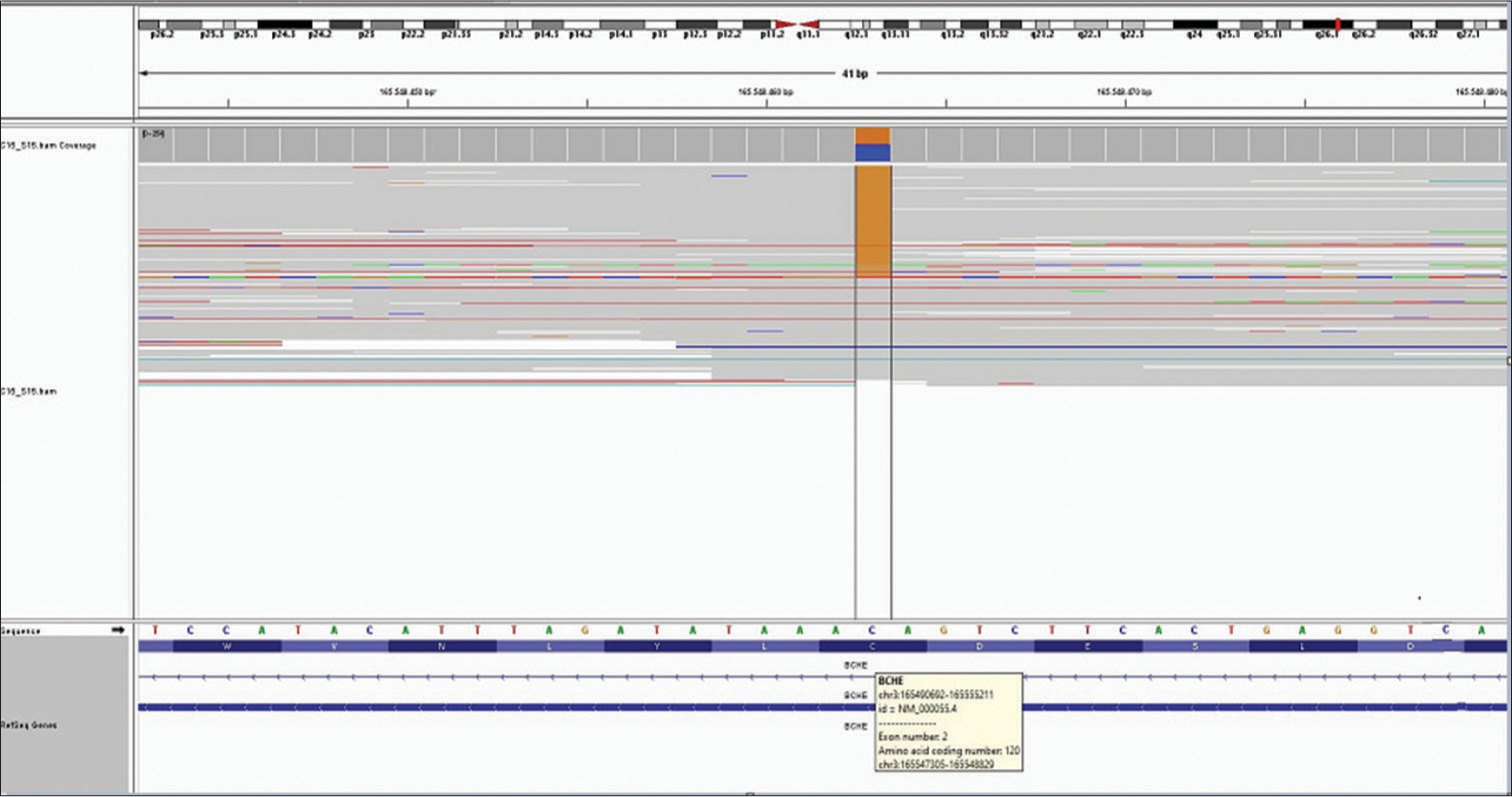Translate this page into:
A likely pathogenic variant in the Butyrylcholinesterase gene was found in an agricultural engineer with a low pseudocholine level

*Corresponding author: Seval Müzeyyen Ecin, Department of Occupational Medicine and Internal Medicine, Mersin City Training and Research Hospital, Mersin, Turkey. seval44ecin@gmail.com
-
Received: ,
Accepted: ,
How to cite this article: Ecin SM, Baser B. A likely pathogenic variant in the Butyrylcholinesterase gene was found in an agricultural engineer with a low pseudocholine level. Glob J Health Sci Res. doi: 10.25259/GJHSR_4_2025
Abstract
Butyrylcholinesterase (BChE) can hydrolyze acetylcholine and partially replace it in case of acetylcholinesterase inhibition or deficiency. In this case report, we aimed to present a case who applied due to coincidental low pseudocholine esterase levels and had a BChE novel variant genetic deficiency, which was expected to be low due to her occupation. The patient was a 29-year-old female. She was admitted to the occupational medicine outpatient clinic for further examination and evaluation after a low level of pseudocholine esterase was detected in the pre-employment tests. The most common causes of low pseudocholine esterase levels are postnatal diseases, medications, and occupational exposures. Even in cases where occupational exposure is considered in the foreground, it should not be forgotten that the occupational anamnesis should be deepened and genetic deficiency may be in the back of our minds.
Keywords
Butyrylcholinesterase
Genetic deficiency
Occupation
Pseudocholine esterase
INTRODUCTION
In humans, there are two types of cholinergic enzymes, acetylcholinesterase (AChE), and butyrylcholinesterase (BChE), which hydrolyze acetylcholine. BChE is the co-regulator of AChE in cholinergic transmission, but the physiological role of BChE is not yet clear.[1] BChE is found in smooth muscles, fat cells, plasma, and serum. Although the function of BChE is not known exactly, it is known that it detoxifies xenobiotics and bioactivates various drugs. Furthermore, BChE can hydrolyze acetylcholine and partially replace it in case of AChE inhibition or deficiency.[2]
The causes leading to a decrease in BChE activity are mostly postnatal factors. The most common causes include liver and kidney disease, dystrophy, burn, malignancy, hypothermia, uremia, and pregnancy.[3-5] The second most common cause is drugs, and the most responsible drugs include anticholinergic drugs, glucocorticoids, oral contraceptives, monoamine oxidase inhibitors, and pesticides, including organophosphates (OPs).[6,7] The other factor is genetic factors.[8]
In this case report, we aimed to present a case who applied due to coincidental low pseudocholine esterase levels and had a BChE novel variant genetic deficiency, which was expected to be low due to her occupation but was not previously detected as a result of evaluations.
CASE REPORT
A 29-year-old female was admitted to the occupational medicine outpatient clinic for further examination and evaluation after a low level of pseudocholine esterase was detected in the pre-employment examination. She worked for 7 years as an agricultural engineer in a company selling pesticides. She only sold packaged products as a salesperson, had no active contact with the products, and was not involved in production. During her employment, her pseudocholine esterase level was not checked either at the start of the job or during her periodic examinations. The pseudocholine esterase level of the patient is given in Table 1.
| Date | Psödokolin level U/L (4900–11900) |
|---|---|
| November 13, 2024 (private hospital) | 3004 |
| November 21, 2024 (private laboratory) | 2869 |
| December 04, 2024 (hospital) | 3178 |
The patient had no active complaints and symptoms, no medication, and no comorbidities. In the physical examination of the patient, head-and-neck system, respiratory system, cardiovascular system, abdominal examination, and extremity examinations were evaluated as normal. She stated that her mother and father lived in her family and she had no additional disease. She did not experience any complications due to a curettage and a nose surgery for which she had anesthesia 2 times. No pathology was detected in the tests which performed, and no organ pathology was detected in abdominal ultrasonography. Hematological and biochemical data are given in Table 2.
| Variable | On presentation | Reference range |
|---|---|---|
| Hemoglobin g/dL | 13.5 | 12–16 |
| Hematocrit % | 39.8 | 36–46 |
| Mean corpuscular volume (fl) | 86.8 | 78–98 |
| WBC×103/uL | 8.08 | 4.5–11 |
| Neutrophil×103/uL | 4.33 | 2–8 |
| Lymphocyte×103/uL | 3.04 | 0.6–34 |
| Basophils×103/uL | 0.05 | 0–0.2 |
| Monocytes×103/uL | 0.41 | 0–0.9 |
| Eosinophils×103/uL | 0.13 | 0.02–0.5 |
| Thrombocyte×103/uL | 359 | 150–450 |
| Glucose mg/dL | 97 | 74–106 |
| Urea | 30 | 20–50 |
| Creatinine mg/dL | 0.8 | 0.5–11 |
| AST U/L | 17 | 13–40 |
| ALT U/L | 17 | 10–49 |
| ALP U/L | 68 | 46–116 |
| GGT U/L | 9 | <38 |
| Total bilirubin mg/dL | 0.46 | 0.3–1.2 |
| Direct bilirubin mg/dL | 0.15 | 0–0.3 |
| Indirect bilirubin mg/dL | 0.31 | |
| HBsAg index | <0.10 (Negative) | 0–0.99 |
| Anti-HBs mIU/mL | 15.9 (Positive) | 0–11.99 |
| Anti-HCV index | 0.05 (Negative) | 0.8–0.99 |
| Anti-HIV index | <0.05 (Negative) | 0–0.999 |
WBC: White blood cell, HBsAg: Hepatitis B surface antigen, HCV: Hepatitis C virus, HIV: Human immunodeficiency virus, AST: Aspartate aminotransferase, ALT: Alanine transaminase, ALP: Alkaline phosphatase, GGT: Gamma-glutamyl transferase, HBs: Hepatitis B surface antibody
The patient was referred to the medical genetics outpatient clinic for genetic evaluation among the reasons for low pseudocholine esterase levels. BChE deficiency (OMIM# 617936) carriage was considered in the patient and for molecular diagnosis, sequence analysis was performed with the next generation sequencing (Miseq-Illumina) method for all coding regions of the BChE gene and exon-intron linkage regions of coding exons from genomic DNA isolated from the patient’s EDTA peripheral blood sample. As a result of the analysis, BChE (NM_000055.4) c359 G>C, p. (Cys 120 Ser) variant was detected as heterozygous. Although the variant detected was previously reported in databases (rs1164843733), it was classified as a likely pathogenic (LP) variant because it fulfilled the criteria of PP3, PM2, and PP2 according to the American College of Medical Genetics and Genomics criteria.[9] It was observed that the variant detected in the database searches was not reported in the literature and ClinVar database in individuals with low pseudocholine esterase levels (affected). The proband was accepted as a carrier for BChE deficiency. The genetic map of the patient is given in Figure 1.

- Genetic map of the patient.
DISCUSSION
Pesticides are an important class of environmental chemical pollutants and have become a major public health concern. OPs account for more than 50% of pesticide use worldwide and it is estimated that their use will increase further until 2030 and will lead to harmful consequences for human health and the environment.[10] Since BChE is abundant in plasma, changes in the enzyme are considered as an indicator of intoxication with OPs and carbamates and changes in this enzyme are used as a biomarker of exposure to OPs.[7] Since our patient was an agricultural engineer, pesticide exposure was considered in the foreground at first glance, and it was assumed that the current pseudocholine esterase level was due to his occupation. However, when the occupational anamnesis was deepened, it was found that the patient did not work in active production departments, was not present in the agricultural lands where pesticides were sprayed, and only sold packaged products in the sales department in the store, and other causes of low levels were considered. Chronic liver disease, kidney disease, and additional medication use were investigated and after they were evaluated as normal, genetic causes were started to be investigated. Inherited hereditary deficiency occurs due to mutations in the BChE gene located on chromosome 3, 3q26.1–q26.2 between nucleotides 165.490.692 and 165.555.260. More than 20 genetic variants in the BChE gene have been found to be associated with this type of disease.[8] However, in our case, to the best of our knowledge, a LP that had not been reported in the literature in affected individuals was detected, and enzyme activity was found to be 60%.
At the start of the job, it should be ensured that the characteristics of the person who will be working and the characteristics of the job he/she will be doing are suitable. The examinations conducted for the purpose of placing in a suitable job are called pre-employment examinations. The examinations conducted for the purpose of determining whether there is an effect despite the precautions taken, early diagnosis and treatment are called periodic examinations.[11] In those working with pesticides and their products, the enzyme pseudocholine esterasesterase is inhibited,[7] and in those working in this sector, pseudocholine esterase levels should definitely be checked both at the start of the job and during the intermittent control examinations to place a suitable job and to evaluate whether there is an effect. In our case, although she has been in this sector for 7 years, the pseudocholine esterase level was not checked during the start of the job and during the intermittent control examinations until the period when she changed jobs.
CONCLUSION
The most common causes of low pseudocholine esterase levels are postnatal diseases, medications, and occupational exposures. Even in cases where occupational exposure is considered in the foreground, it should not be forgotten that the occupational anamnesis should be deepened and genetic deficiency may be in the back of our minds. Our case was identified as an affected individual with a low level of pseudocholine esterase, and although genetic counseling was given to the patient, we wanted to emphasize that the patient should be more careful about protective measures while working in his/her profession, which he/she will continue throughout his/her life due to this genetic deficiency, and that genetic changes should be kept in mind in those working in risky jobs.
Ethical approval
Institutional Review Board approval is not required.
Declaration of patient consent
The authors certify that they have obtained all appropriate patient consent.
Conflicts of interest
There are no conflicts of interest.
Use of artificial intelligence (AI)-assisted technology for manuscript preparation
The authors confirm that there was no use of artificial ıntelligence (AI)-assisted technology for assisting in the writing or editing of the manuscript and no images were manipulated using AI.
Financial support and sponsorship: Nil.
References
- Review of human butyrylcholinesterase structure, function, genetic variants, history of use in the clinic, and potential therapeutic uses. Pharmacol Ther. 2015;148:34-46.
- [CrossRef] [PubMed] [Google Scholar]
- Cholinergic blockade of neuroinflammation: From tissue to RNA regulators. Neuronal Signal. 2022;6:NS20210035.
- [CrossRef] [PubMed] [Google Scholar]
- Significance of preoperative butyrylcholinesterase level as an independent predictor of survival in patients with upper urinary tract urothelial carcinoma treated with nephroureterectomy. Jpn J Clin Oncol. 2017;48:1-6.
- [CrossRef] [PubMed] [Google Scholar]
- Muscular dystrophy with laminin deficiency decreases the content of butyrylcholinesterase tetramers in sciatic nerves of Lama2dy mice. Neurosci Lett. 2002;331:155-8.
- [CrossRef] [PubMed] [Google Scholar]
- Neuromuscular pharmacodynamics of mivacurium in adults with major burns. Br J Anaesth. 2011;106:675-9.
- [CrossRef] [PubMed] [Google Scholar]
- Pseudocholinesterase enzyme deficiency: A case series and review of the literature. Cases J. 2009;2:9148.
- [CrossRef] [PubMed] [Google Scholar]
- Pesticides in fine airborne particles: From a green analysis method to atmospheric characterization and risk assessment. Sci Rep. 2017;7:2267.
- [CrossRef] [PubMed] [Google Scholar]
- Identification of a frameshift mutation responsible for the silent phenotype of human serum cholinesterase, Gly 117 (GGT----GGAG) Am J Hum Genet. 1990;46:934-42.
- [Google Scholar]
- Standards and guidelines for the interpretation of sequence variants: A joint consensus recommendation of the American college of medical genetics and genomics and the association for molecular pathology. Genet Med. 2015;17:405-24.
- [CrossRef] [PubMed] [Google Scholar]
- Antioxidants in organophosphorus compounds poisoning. Arh Hig Rada Toksikol. 2013;64:169-77.
- [CrossRef] [PubMed] [Google Scholar]
- Occupatıonal health and safety occupational diseases Ankara: Hacettepe University Publications; 2020.
- [Google Scholar]







